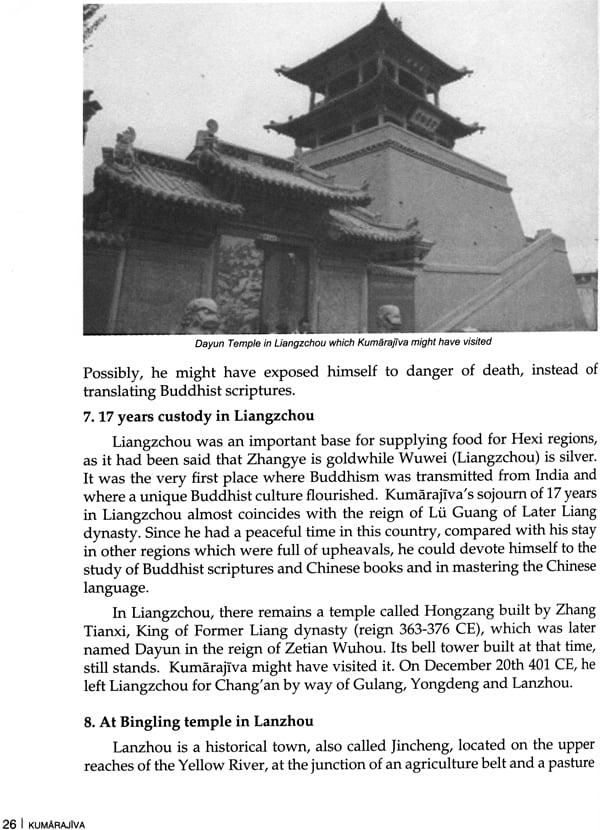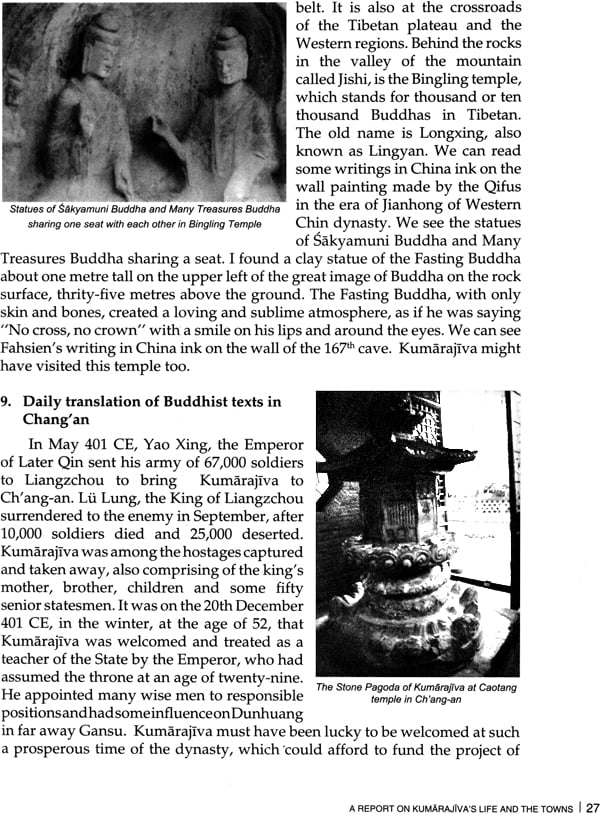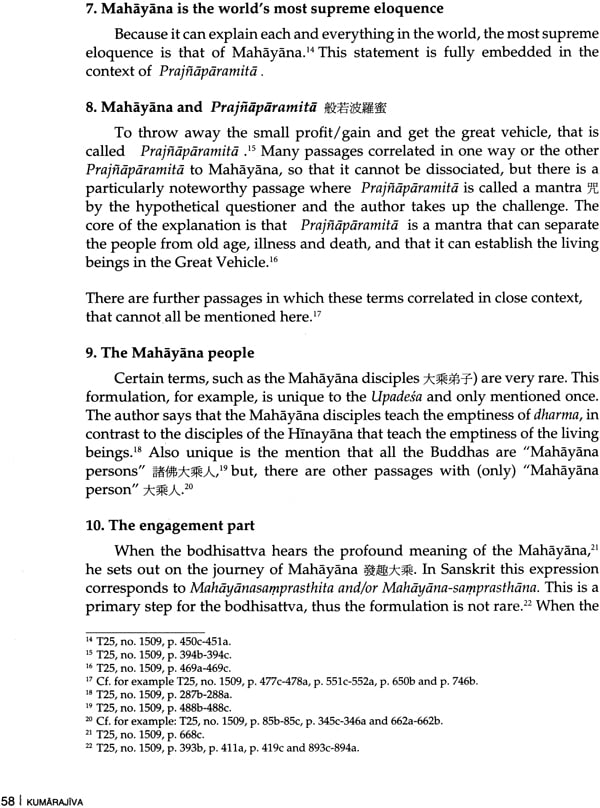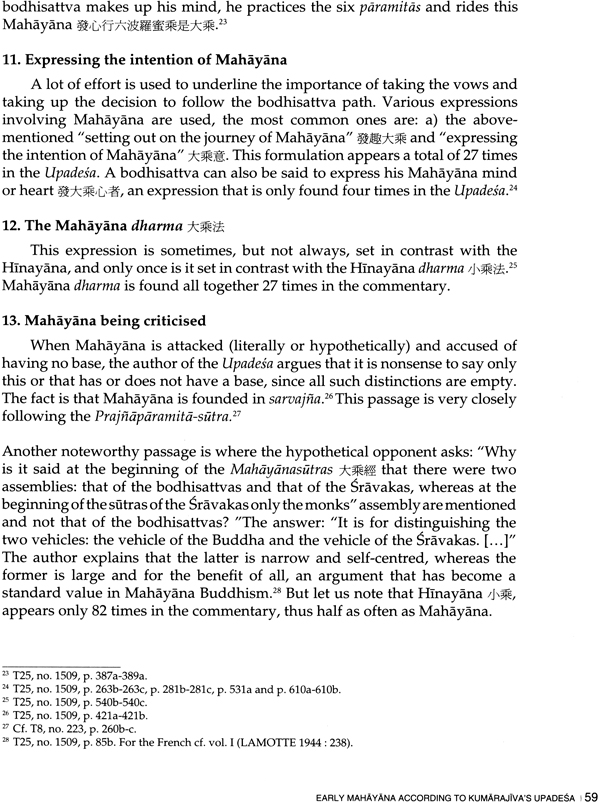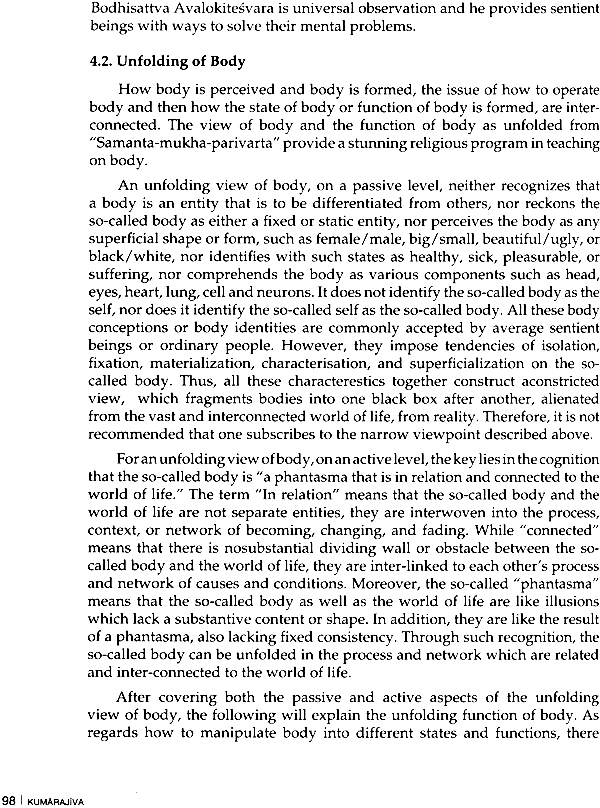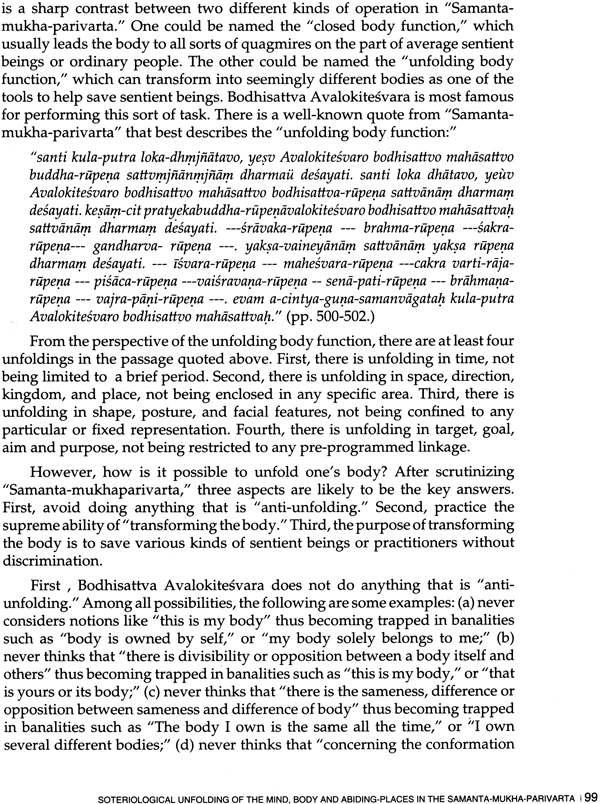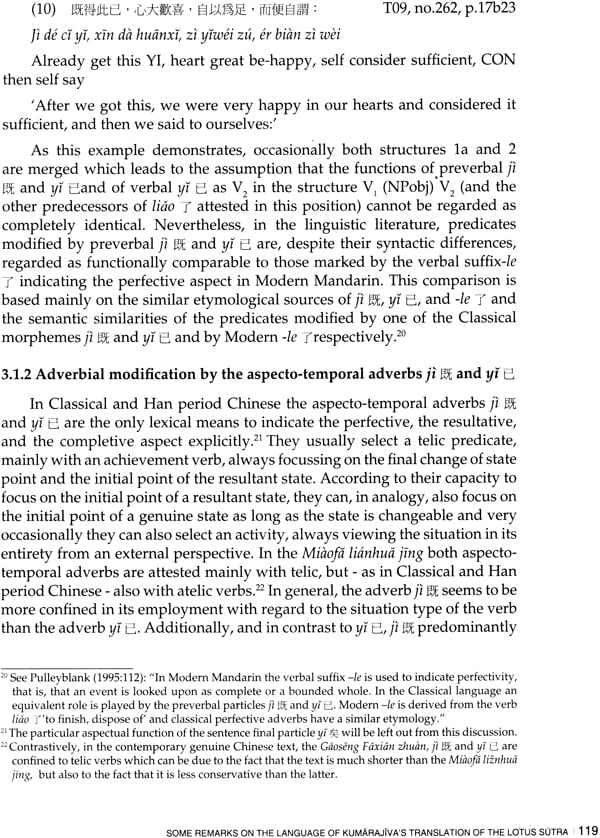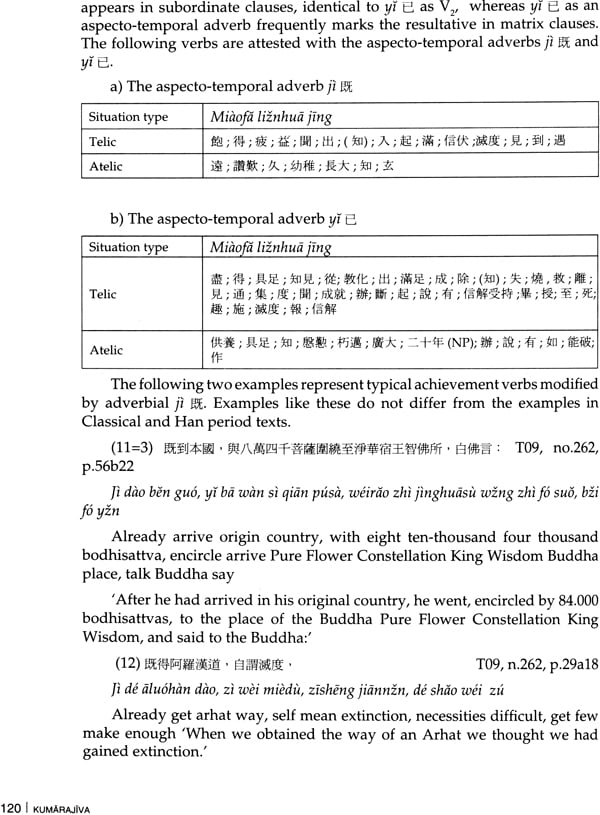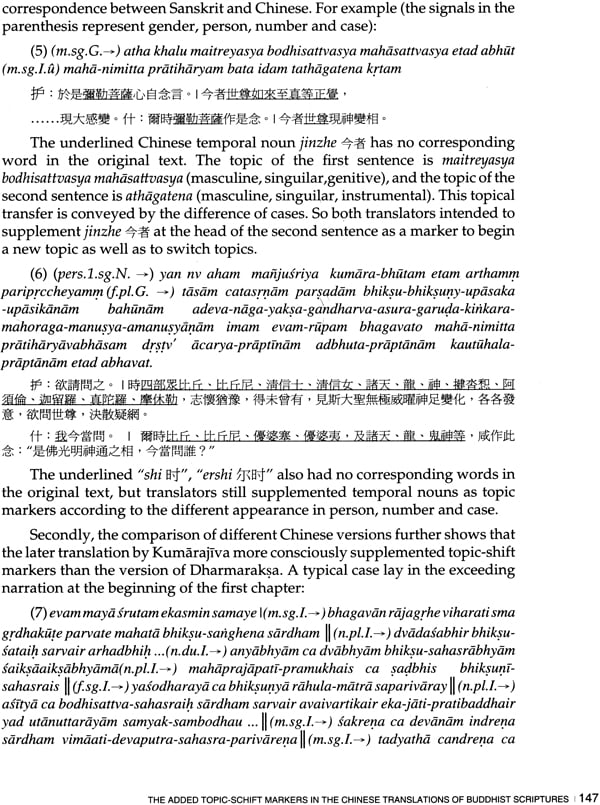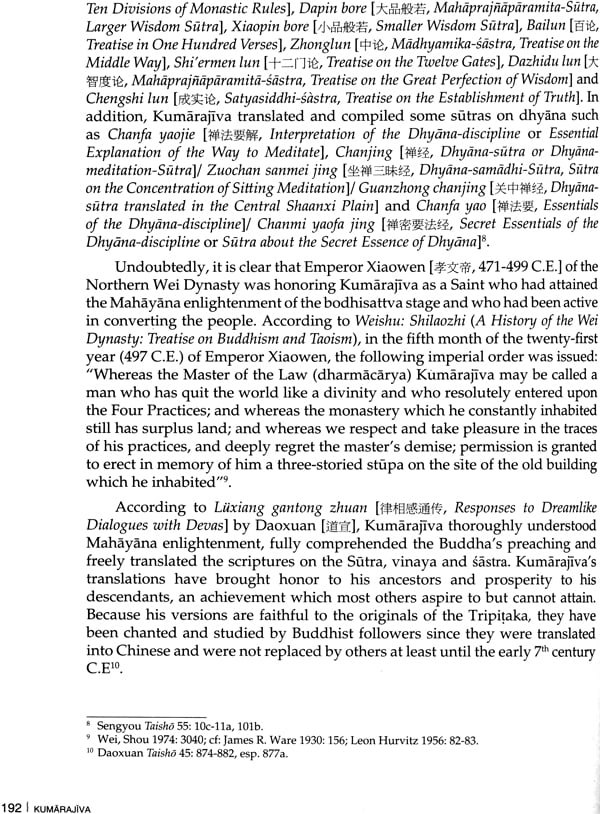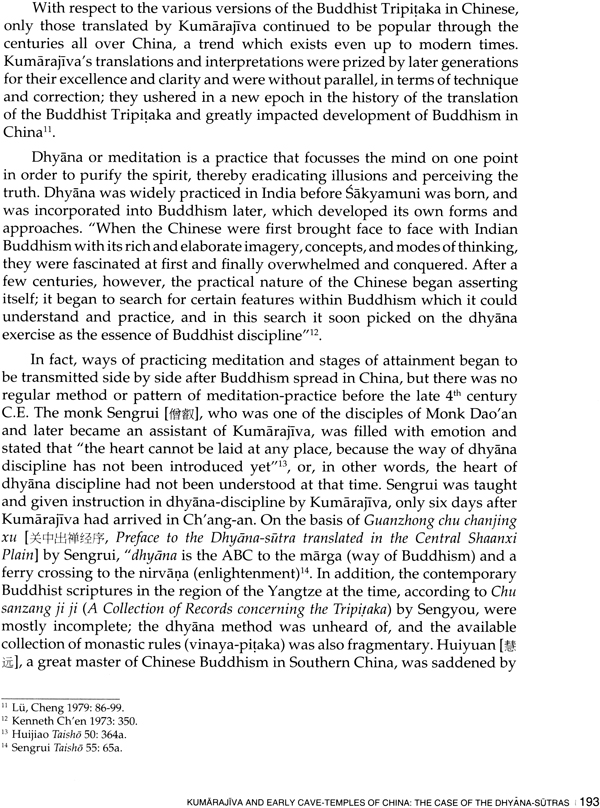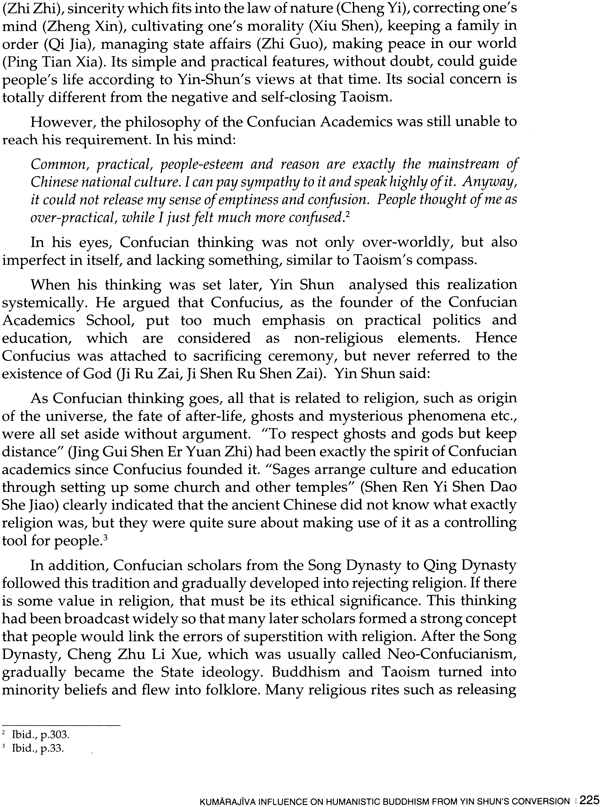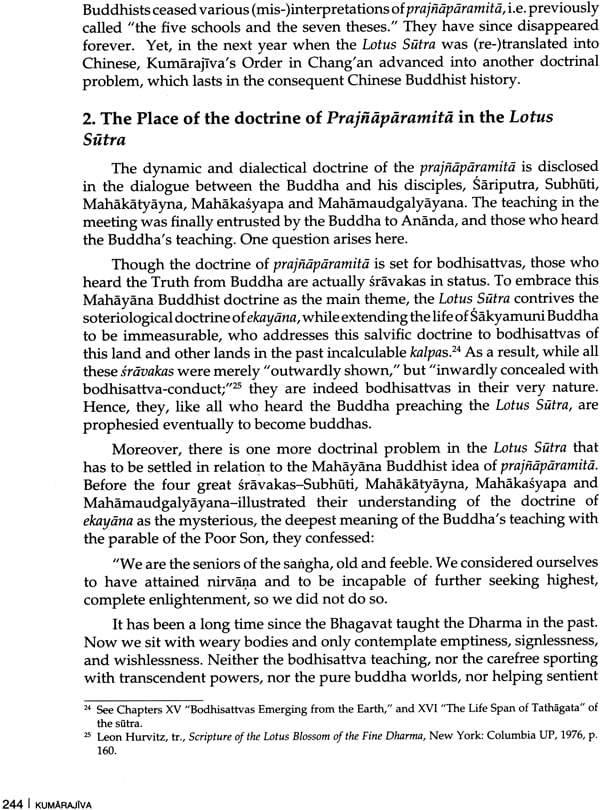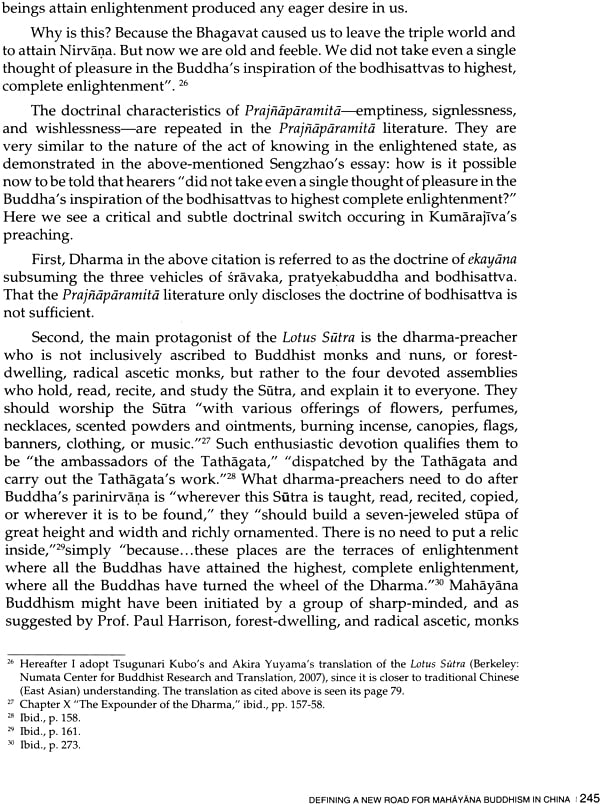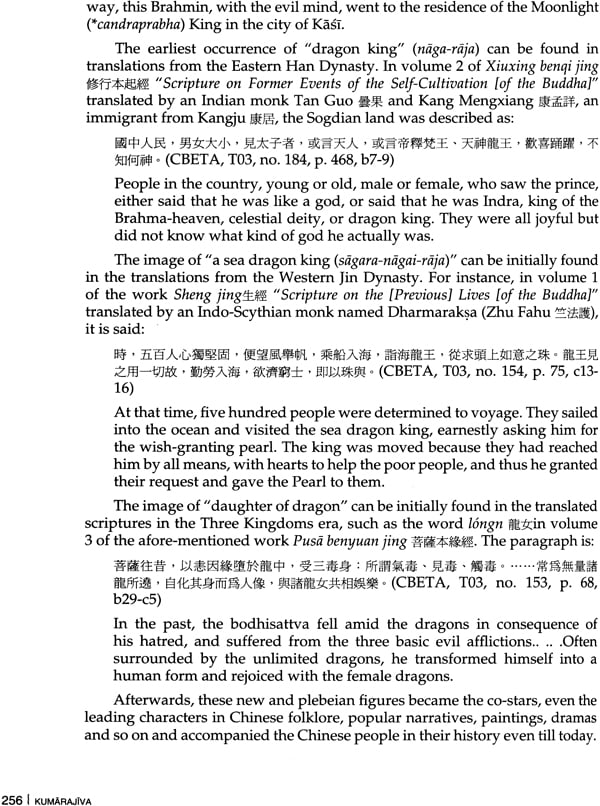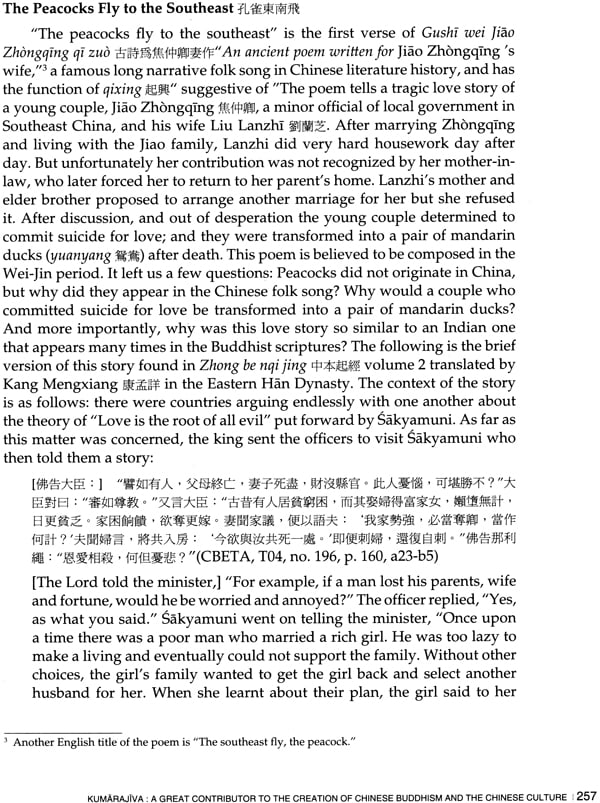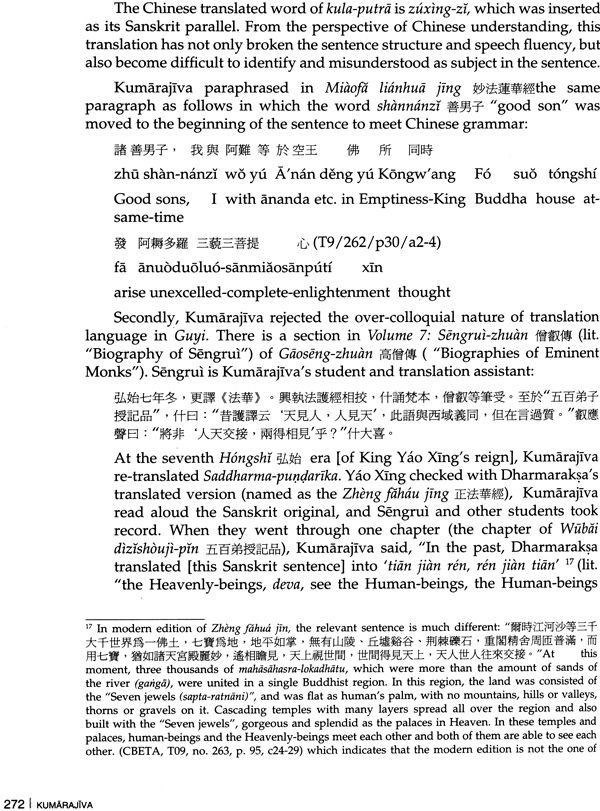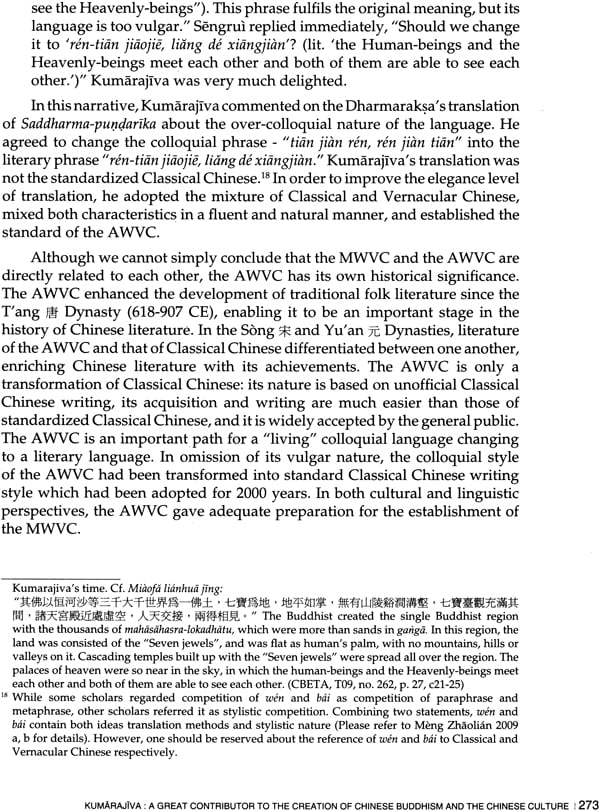
Kumarajiva: Philosopher and Seer
Book Specification
| Item Code: | NAK622 |
| Author: | Shashibala |
| Publisher: | Indira Gandhi National Center for the Arts and D. K. Printworld Pvt. Ltd. |
| Language: | English |
| Edition: | 2015 |
| ISBN: | 9789380935614 |
| Pages: | 362 (40 B/W Illustrations) |
| Cover: | Hardcover |
| Other Details | 11.0 inch x 8.5 inch |
| Weight | 1.30 kg |
Book Description
About the Book
Kumarajiva. (Jiumoluoshi in Chinese), a philosopher and seer, had a long cherished mission: propagation of the true spirit of Buddhism. He broke political, geographical, cultural and linguistic barriers; travelled through barren lands and rivers, mountains and forbidding terrains to bequeath to us a casket of sacred sutras as the most authoritative presentations by translating them from Sanskrit into Chinese. He created pure, boundless and unthinkable versions of the sutras as an obeisance to the sacred voice so that one could bathe in the pure pond of the Dharma.
"Kumarajiva: Philosopher and Seer" is a compendium of recent researches on the brilliance that ushers through his legacy, enshrined in thousands of monasteries in China, Korea and Japan, preserving the heritage - his translations of the sacred Sanskrit texts copied over the last sixteen centuries. The life of Kumarajiva was unique in every aspect. His works inspired members of Imperial houses, Emperors, writers and artists, pilgrims and philosophers. His angelic presence can still be felt in the monastic establishments, in the sound of recitation of sutras and in the lives of the people that have been inspired over the centuries by his translations.
The researches done by scholars from world academia are included in the present volume on his date of birth, the towns and villages where he spent his life from childhood to nirvana, historically important events of his life, his contemporaries, his contribution to the cultural sphere of East Asia especially defining a new road for Mahayana Buddhism, philosophical theories and vision, comparative studies of his translations and echoes of his translations in Chinese literature.
About the Author
Dr. Shashibala is a scholar in the areas of Buddhst art and iconography and cross cultural connection among Asian countries. As Research Professor at the International Academy of Indian Culture, New Delhi founded by Prof. Raghu Vira, she has authored nine books on Art of the Shingon sect, Buddhist Art, Menifestations of Budddhas, Divine Art Atisha and a biography of one of the world renowned scholar Late Prof. Raghu Vira. 60 research papers contributed by her on various subjects and presented at International conferences and seminars, have been published by various organizations in India and abroad. She taught ’History of Arts’ for fifteen years at the National Museum Institute (a deemed University) New Delhi; As a researcher She has travelled to the USA, UK, Germany, Nepal, France, Belgium, Russia, China, Japan, Indonesia, Thailand, Malaysia, Singapore etc. Her exhibition illustrated lectures, and radio broadcastings are highly acclaimed. At the Indira Gandhi National Centre for the Arts she has organised international conference and exhibitions on Kumarajiva and Atisa. Her well researched exhibitions on Sanskrit and Indian Culture: Voyages are travelling in India and aboroad. She worked as academic advisor and coordinator for organizing international seminars at Bharatiya Vidya Bhavan on “Sanskrit on the Silk Route” and Sanskrit through the Maritime Route”. The publication of these proceeding is also in progress.
Foreword
India and China both are ancient civilizations of the world. Buddhism with its origin in India became the major cultural link between these two oldest continuing civilizations. Buddhist savants from India travelled to China, risking their own lives by crossing deserts and oceans to spread the spiritual message. Many from China also took pilgrimage to India on the quest of the Dharma and collected Buddhist scriptures. By this, these savants and pilgrims contributed not only to the spread of Buddhism but also facilitated understanding of social and economic relations of Indian civilization to Central Asia and China. Though the ancient records of India are silent about them but there are large number of documents preserved in Chinese and Central Asian languages in which a few Chinese records have been discovered narrating the lives and works of eminent Buddhist monks and scholars.
Kumarajiva was one of the most eminent Buddhist scholars who broke political, geographical, cultural and linguistic barriers with a long cherished mission of the propagation of true spirit of Buddhism. His father was an Indian (Kashmiri) brahmin and mother a Kuchean princess. He studied Buddhist doctrines in Kucha, Kashmir, and in Kashgar under great teachers. Thus, he developed himself as a brilliant monk who was well versed in the Buddhist learning of the schools, then current in northern India. With his thorough study of Chinese language while in captivity, taking up the translation of Buddhist scriptures sponsored by the state, presiding over a team of Chinese specialists before an audience of hundreds of monks, he translated a large number of Buddhist texts into Chinese. In the collection of his translated works some are the most important texts now available only through his translations.
Kumarajiva's legacy is preserved in thousands of monasteries in China, Korea and Japan in his translations of sacred Sanskrit texts copied over last sixteen centuries. His works have inspired members of imperial houses, Emperors, writers, artists, pilgrims and philosophers. The canvas covering his life and legacy spans from Kashmir to Japan running through mountains, snow covered hills, barren deserts and green valleys.
Indira Gandhi National Centre for the Arts organised an International seminar on "Kumarajiva : Philosopher and Seer" in February 2011 to study closely the life and contributions of Kumarajiva in enhancement of India-China cultural relations. It is gratifying to place in the hands of scholars this collection of research papers that throws significant light on various aspects related to the life and works of Kumarajiva.
I am grateful to the Chinese and Indian scholars, as well as the scholars from other countries for their contribution to this volume. My gratitude to Dr. Shashibala for editing this volume. She was also the coordinator of the seminar along with the exhibition on Kumarajiva. I am thankful to Dr. Advaitavadini Kaul, Chief Editor, IGNCA for her careful handling of the publication and seeing it through press.
I hope the volume will inspire more scholars and readers of the two countries to strengthen existing contacts and enhance the cordial understanding and co- operative relationship between the two countries.
Preface
Indira Gandhi National Centre for the Arts (IGNCA) had organised a three- day international conference on 3rd_5th February 2011 on the life and legacy of Kumarajiva, an outstanding Buddhist master of the 4th-5th century CE, whose mission in life was the promotion of universal human values which arise from within, evolving from a blend of individual experiences and collective consciousness. Born out of royal blood from his mother's side, and an aristocratic lineage from his father's he inherited his spiritual doctrine from both. His impeccable pedigree and rigorous education made him an icon of wisdom and sacrifice, gave him vajra like determination and spurred him to constant effort. His life was unique in all aspects - from parentage and education to old age and nirvana.
He saw many vicissitudes in his eventful life, starting from being a hostage of war to becoming Rajyaguru. Through his translations of Buddhist texts from Sanskrit into Chinese he established ethical and aesthetical, physical and spiritual value systems for the people of East Asia. His translations are recited in monasteries to this day. With him, secular became sacred and sacred became secular. Under his tutelage, politically divided China was united for the first time. His teachings continue to be relevant in this age of globalization.
The research papers presented during the conference covered several areas concerning his life and legacy. The paper by Sylvie Hureau deals with the question of the date of Kumarajiva's birth which has a considerable significance as it could be helpful in fixing the date of his arrival in Ch' ang- an as well as to understand his relations with his disciples. The documention presented by Katsuhisa Yamada is based on his visits to the towns and villages associated with Kumarajiva - Kashgar, Tumushuk, Kucha, Loulan, Dunhuang, Liangzchou and Ch'ang-an - the various places where Kumarajiva was born, educated, travelled and translated many texts from Sanskrit into Chinese. He was taken as booty of war by the Chinese and raised to the status of Rajyaguru. BR Deepak's paper traces the history of "Kumarajiva in China: from war booty to Rajyaguru ", exploring civilizational dialogue between India and China.
Harprasad Ray's paper is titled "Kumarajiva and his contemporaries". It outlines the political circumstances of the period and explains the Buddhist philosophical scenario preceding the time of Kumarajrva. The earlier masters gained faith and confidence of the rulers by taking recourse to the supernatural resorting to magical powers.
The first image of the Buddha ever made in India, believed to have been brought to China by Kumarajiva and his father, copied by monk Chonen from Japan, was either destroyed during the Boxer Rebellion or was carried off to Russia as booty. In his paper Kimiaki Tanaka presents his findings on the sandalwood image.
The paper on "Early Mahayana according to Kumarajiva's Upadesa" by EIsa Legittimo talks about the denomination Mahayana in the Upadesa, the metaphor of the Mahayana Ocean, Karuna as the foundation of Mahayana, Mahayana as the world's most supreme eloquence etc. According to the paper the Bodhisattva is the main protagonist of the Upadesa.
Saroj Kumar Chaudhary discusses if Sanskrit taught by Kumarajiva played any role in innovation or dissemination of the Fan-ch'ieh spelling method, and if it was in any way associated with the invention of 'Recent Style Poetry' (Chin-t'i-shi). Kumarajiva's translation of the Lotus Sutra, is the central scripture for T'ien T'ai Buddhists in China and Tendai and Nichiren Buddhism in Japan. Yoichi Kawada studies the journey "From Kumarajiva to Nichiren - connected through Myoho-Renge-Kyo". Yao-ming Tsai in his paper "Soteriological unfolding of the mind, body and abiding places in the 'Samantamukhaparivarta' of the Lotus Sutra" employs it as the main source to discuss with a philosophical approach the possibility of the most superlative unfolding of three concepts, namely mind, body and abiding-places in practice and application of Mahayana Buddhism.
Barbara Meisteremst brings to light peculiarities of the language of Kumarajiva's translation of the Lotus Sutra. Her analysis of the language of the Lotus Sutra is based on a previous and more general investigation of the temporal and aspectual structures of early Buddhist texts. Kumarajiva is evidently more conservative in his grammatical structure than the original Chinese text written by Fahien. "The added topic-shift markers in the Chinese translations of Buddhist scriptures: A Sanskrit-Chinese comparative analysis of the Lotus Surra" by Jiang Nan is based on a Chinese-Sanskrit comparative analysis of the Lotus Sutra and a comparative study of its different Chinese translations. The paper explores the structural features of the texts in Chinese translations of Buddhist scriptures.
"Kumarajiva and Abhidharma" by Charles Willemen states that although the Sarvastivadins were the most influential school in Candharan cultural area - certainly in Bactria - during the first centuries CE, the reality was more complex. He talks about the texts which give an idea about Kumarajrva's knowledge of Abhidharmic traditions in his time. Bill M. Mak throws light on "Kumarajiva and Prajriaparamita in China". He addresses a number of issues concerning these texts: Lesser and Greater and Vajracchedika, and the important commentary Prajnaparamitopadesa, attributed to Nagarjuna, from both, a philological as well as historical perspective.
Kin Tung Yit in "Two Traditions of Sravaka Meditation: Kumarajiva's Zuo chan san mei jing and Buddhaghosa's Visuddhimagga", has done a comparative study of Kumarajiva's "Sitting Meditation Samadhi Sutra" and Buddhaghosa's Visuddhimagga, and he aims to explore the main practices of the Sravaka meditation in these two Buddhist meditation manuals. The tradition of Dhyana by Buddhist monks in northern China during 4th-6th centuries has been reflected in many cultural spheres. Dhyana-sutras translated by Kumarajiva became the basis of Buddhist cave temples. Chongfeng Li in "Kumarajiva and early cave-temples of China: the case of the Dhyana-sutras", co-relates art, literature and history.
Liu Cheng-you has discussed "Kumarajiva's influence on humanstic Buddhism from Vim Shun's conversion". Many Chinese intellectuals shouldered responsibility for the promotion of nationalism and withstood great pain. The contemporary Buddhist movement was always led by Yinshun's thought in China which had its roots in the thought of Nagarjuna which was translated by Kumarajiva.
Po-kan Chou in his paper "Defining a new road for Mahayana Buddhism in China" refutes the earlier research on the history of Mahayana, presenting his argument that laity is indeed the main driving force in China rather than in India. According to him it was mainly defined by the Lotus Sutra rather than any other Buddhist text. Zhn Qingzhi's paper focuses on Kumarajiva's contribution in creation of Chinese Budhism and the Chinese culture.
Paula Tizzano Femandez offers a detailed research on "Kumarajiva's visibility: research in translation studies". He relied on biographical markers which facilitate exploration of his translation theories from a hermeneutic- philosophical approach, the cognitive acquisition of his translating competence, his sense of mission and purpose, and the singularities of his forerunning translators' school. Lastly, from an action-theory paradigm, she investigates the extent to which his methodology of "oral translation-master class-collective workshop" could be applied today in the training of specialized translators.
Liu Yingsheng's paper examines the materials written during 13th and 14th centuries CE. "History of the Sixteen Kingdoms" is the first that mentions Kumarajiva's translations. Shortly thereafter, it was repeated by Hui Jiao (497 -554 CE) in his "Biographies of the Famous Monks".
Guilaine Mala has searched references to "Kumarajiva in 18th century Tibetan Sources", another valuable contribution to the works on Kumarajiva. Fan Jingjing's paper is on Kumarajiva's contribution to Chinese literature focusing on his translation of Vimalakirtinirdesasutra which is one of the most popular sutras that has exerted a great influence on Chinese literature since Six Dynasties.
In Japan, sutras were copied for presenting as offerings at temples in large numbers. When these piled up, they were tied into bundles and immersed in flowing water. Many of them were unearthed from river banks or dried up beds. A report on such sutras translated by Kumarajiva is presented by Yu Inoue in "The third case unearthed Kokera Sutra copy of Diamond Wisdom Sutra translated by Kumarajiva ... " "The influence of Sutras translated by Kumarajiva on the development of Mahayana Buddhism in Japan" by Gensei Ho, traces the history of Mahayana Buddhism in Japan from its official advent to the present day, stating that 62,000 temples out of the existing 75,000 belong to the sects based on the sutras translated by Kumarajiva. Bachchan Kumar's paper focuses on "Kumarajiva and Madhyamaka school of thought". Kumarajiva was a Kashmirian from his father's side. His mother took him to Kashmir for studies. Advaitavadani Kaul in her paper on "Kumarajiva: his connections with Kashmir and the development of Buddhist lore" attempts to trace the state of Buddhism in Kashmir during the 4th -5th century CE and the impact of the Buddhist scholars of Kashmir outside Kashmir.
The present volume is an excellent collection of research papers adding insight and new dimensions to the body of works done on great masters and pilgrims who contributed towards cultural advancement through transcendence in life.
I am grateful to IGNCA for giving me an opportunity to organize this international conference and curate an exhibition on the 'Life and Legacy of Kumarajiva' whose memories have gone into amnesia. On behalf of IGNCA, I sincerely thank all those who contributed towards making this conference successful. Moreover I am grateful to all those who contributed their documentation for a photo exhibition on "Life and Legacy of Kumarajiva" from remote areas in China especially from the Silk Route and various collections from Japan, making the event rewarding and memorable.
Contents
| Foreword | ||
| Contributors | ||
| Preface | ||
| 1 | Kumarajiva's date of birth | Jan-16 |
| 2 | A report on Kumarajiva's life and the towns associated with him | 17-30 |
| 3 | Kumarajiva in China: from war booty to Rajyaguru | 31-38 |
| 4 | Kumarajiva (CE 344-409 or 413) and his contemporaries | 39-45 |
| 5 | Kumarajiva and the sandalwood image | 46-53 |
| 6 | Early Mahayana according to Kumarajiva's Upadesa | 54-61 |
| 7 | Kumarajiva and the Chinese academic world | 62-71 |
| 8 | From Kumarajiva to Nichiren-connected through Myoho-Renge-Kyo | 72-87 |
| 9 | Soteriological unfolding of the mind, body and abiding | 88-108 |
| 10 | Some remarks on the language of Kumarajiva's translation of the | 109-143 |
| 11 | The added topic-shift markers in the Chinese translations of | 144-152 |
| 12 | Kumarajiva and Abhidharma | 153-158 |
| 13 | Kumarajiva and Prajnaparamita in China | 159-177 |
| 14 | Two traditions of Sravaka meditation: Kumarajiva's Zuo chan san | 178-189 |
| 15 | Kumarajiva and early cave-temples of China: the case of the | 190-221 |
| 16 | Kumarajiva's influence on humanistic Buddhism from Yin Shun's | 222-236 |
| 17 | Defining a new road for Mahayana Buddhism in China | 237-250 |
| 18 | Kumarajiva: a great contributor to the creation of Chinese | 251-275 |
| Buddhism and the Chinese culture | ||
| 19 | Kumarajiva's visibility: research in translation studies | 276-286 |
| 20 | Kumarajiva and his translation of Buddhists Classics viewed | 287-293 |
| through the Chinese literature of 13th and 14th century | ||
| 21 | Kumarajiva in 18th-century Tibetan sources | 294-308 |
| 22 | Kumarajiva's translation of Vimalakirtinirdesa and its contribution to Chinese literature | 309-316 |
| 23 | The third case unearthed Kokera Surra copy of Diamond Wisdom | 317-321 |
| Sutra translated by Kumarajiva excavated at Tenjinnbata | ||
| historic site, Shiga prefecture | ||
| 24 | The influence of Sutras translated by Kumarajiva on the | 322-327 |
| development of Mahayana Buddhism in Japan | ||
| 25 | Kumarajiva and Madhyamaka school of thought | 328-336 |
| 26 | Kumarajiva : his connections with Kashmir and the development of Buddhist lore | 337- 346 |
